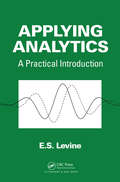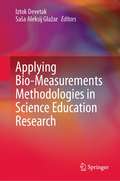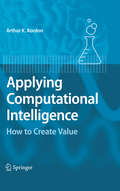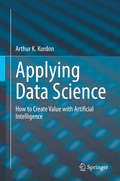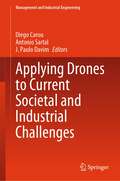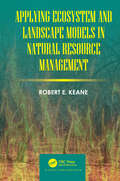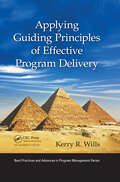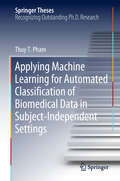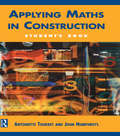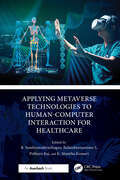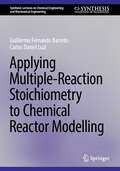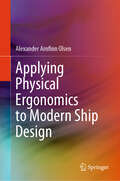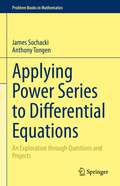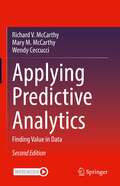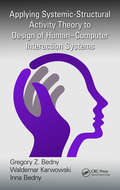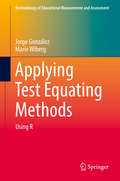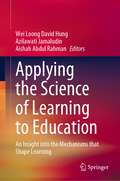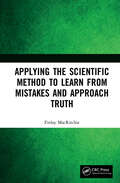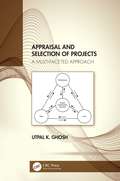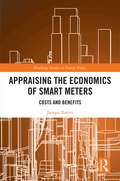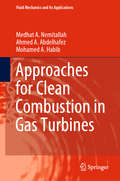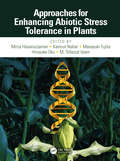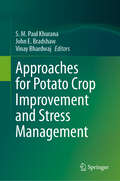- Table View
- List View
Applying Analytics: A Practical Introduction
by E. S. LevineNewcomers to quantitative analysis need practical guidance on how to analyze data in the real world yet most introductory books focus on lengthy derivations and justifications instead of practical techniques. Covering the technical and professional skills needed by analysts in the academic, private, and public sectors, Applying Analytics: A Practic
Applying Bio-Measurements Methodologies in Science Education Research
by Iztok Devetak Saša Aleksij GlažarThis book illustrates the problems of using eye tracking technology and other bio-measurements in science education research. It examines the application of bio-measurements in researching cognitive processes, motivation for learning science concepts, and solving science problems. Most chapters of this book use the eye-tracking method, which enables following the focus of the students’ attention and drawing conclusions about the strategies they used to solve the problem. This book consists of a total of fifteen chapters. Authors from eight countries emphasise the same trends despite their cultural and educational differences. The book begins with general chapters describing cognitive processes and how these processes are measured using eye-tracking methods and other psychophysiology parameters and motivation. Finally, the book concludes the chapters presenting studies in specific scientific fields from chemistry, biology, physics and geology.
Applying Computational Intelligence: How to Create Value
by Arthur KordonThe flow of academic ideas in the area of computational intelligence is impacting industrial practice at considerable speed. Practitioners face the challenge of tracking, understanding and applying the latest techniques, which often prove their value even before the underlying theories are fully understood. This book offers realistic guidelines on creating value from the application of computational intelligence methods. In Part I, the author offers simple explanations of the key computational intelligence technologies: fuzzy logic, neural networks, support vector machines, evolutionary computation, swarm intelligence, and intelligent agents. In Part II, he defines the typical business environment and analyzes the competitive advantages these techniques offer. In Part III, he introduces a methodology for effective real-world application of computational intelligence while minimizing development cost, and he outlines the critical, underestimated technology marketing efforts required. The methodology can improve the existing capabilities of Six Sigma, one of the most popular work processes in industry. Finally, in Part IV the author looks to technologies still in the research domain, such as perception-based computing, artificial immune systems, and systems with evolved structure, and he examines the future for computational intelligence applications while taking into account projected industrial needs. The author adopts a light tone in the book, visualizes many of the techniques and ideas, and supports the text with notes from successful implementations. The book is ideal for engineers implementing these techniques in the real world, managers charged with creating value and reducing costs in the related industries, and scientists in computational intelligence looking towards the application of their research.
Applying Data Science: How to Create Value with Artificial Intelligence
by Arthur K. KordonThis book offers practical guidelines on creating value from the application of data science based on selected artificial intelligence methods. In Part I, the author introduces a problem-driven approach to implementing AI-based data science and offers practical explanations of key technologies: machine learning, deep learning, decision trees and random forests, evolutionary computation, swarm intelligence, and intelligent agents. In Part II, he describes the main steps in creating AI-based data science solutions for business problems, including problem knowledge acquisition, data preparation, data analysis, model development, and model deployment lifecycle. Finally, in Part III the author illustrates the power of AI-based data science with successful applications in manufacturing and business. He also shows how to introduce this technology in a business setting and guides the reader on how to build the appropriate infrastructure and develop the required skillsets. The book is ideal for data scientists who will implement the proposed methodology and techniques in their projects. It is also intended to help business leaders and entrepreneurs who want to create competitive advantage by using AI-based data science, as well as academics and students looking for an industrial view of this discipline.
Applying Drones to Current Societal and Industrial Challenges (Management and Industrial Engineering)
by J. Paulo Davim Diego Carou Antonio SartalThis book explores drone applications and the cutting-edge technologies that drive their functionality. From transforming everyday challenges like traffic congestion to enhancing efficiency in fields such as search and rescue operations, protection of critical infrastructure, and medicine, the book explores how drones serve as powerful allies to address diverse human needs. The chapters not only showcase the applications of drone technology but also shed light on how these vehicles can revolutionize commonplace tasks, such as delivering packages with unprecedented efficiency. The book also explores technological intricacies, regulatory considerations, and the evolving demands of today's consumers. By providing a holistic view, it equips readers with a deep understanding of the multifaceted landscape surrounding drone technology.
Applying Ecosystem and Landscape Models in Natural Resource Management
by Robert E. KeaneManaging today’s lands is becoming an increasingly difficult task. Complex ecological interactions across multiple spatiotemporal scales create diverse landscape responses to management actions that are often novel, counter-intuitive and unexpected. To make matters worse, exotic invasions, human land use, and global climate change complicate this complexity and make past observational ecological studies limited in application to the future. Natural resource professionals can no longer rely on empirical data to analyze alternative actions in a world that is rapidly changing with few historical analogs. New tools are needed to synthesize the high complexity in ecosystem dynamics into useful applications for land management. Some of the best new tools available for this task are ecological and landscape simulation models. However, many land management professionals and scientists have little expertise in simulation modeling, and the costs of training these people will probably be exorbitantly high because most ecosystem and landscape models are exceptionally complicated and difficult to understand and use for local applications. This book was written to provide natural resource professionals with the rudimentary knowledge needed to properly use ecological models and then to interpret their results. It is based on the lessons learned from a career spent modeling ecological systems. It is intended as a reference for novice modelers to learn how to correctly employ ecosystem landscape models in natural resource management applications and to understand subsequent modeling results.
Applying Guiding Principles of Effective Program Delivery
by Kerry R. WillsWhile today's programs continue to grow in size and complexity, their success rates remain low. To manage programs effectively in this environment, project managers and program managers must take a consultative approach that applies a core set of guiding principles across every function of the program. This book explains what it means to take a consultative approach. Instead of focusing on specific program management techniques, it covers the guiding principles required to make those techniques effective-making it applicable to any program in any industry.
Applying Lean Six Sigma in the Pharmaceutical Industry
by Bikash ChatterjeeBikash Chatterjee emphasizes the criticality of applying the principles of Lean and Six Sigma within the paradigm of the drug development process. His guide to operational excellence in the pharmaceutical and biotech industries is a focused summary of the application of Lean Six Sigma theory to the regulated life sciences. From molecule discovery to the application of PAT Applying Lean Six Sigma in the Pharmaceutical Industry will highlight the importance of framing these initiatives within the key deliverables of drug development manufacturing and quality. Challenging conventional wisdom the author offers a quality and efficiency perspective as a foundation for the principles of Quality by Design, PAT and the new philosophies underlying Process Validation. Each chapter includes discussion around the considerations for applying Lean manufacturing and Six Sigma principles and their tools, culminating in a case study to illustrate the application. The book is organized to reflect the major work centers involved in the drug development lifecycle. Each chapter is stand-alone but together they illustrate the necessary synergy between Lean, Six Sigma and compliance sensibilities required to be successful in the pharmaceutical industry. These design, manufacturing and management techniques are not without their challenges. Bikash Chatterjee's book offers the roadmap for an industry that is struggling to reinvent many of its development and business processes.
Applying Machine Learning for Automated Classification of Biomedical Data in Subject-Independent Settings (Springer Theses)
by Thuy T. PhamThis book describes efforts to improve subject-independent automated classification techniques using a better feature extraction method and a more efficient model of classification. It evaluates three popular saliency criteria for feature selection, showing that they share common limitations, including time-consuming and subjective manual de-facto standard practice, and that existing automated efforts have been predominantly used for subject dependent setting. It then proposes a novel approach for anomaly detection, demonstrating its effectiveness and accuracy for automated classification of biomedical data, and arguing its applicability to a wider range of unsupervised machine learning applications in subject-independent settings.
Applying Maths in Construction
by John Humphreys Antoinette TourretThis book and its accompanying Teacher's Pack are the result of a project, supported by the Nuffield Foundation, to provide flexible learning materials for the Basic Application of Number core skill for both the NVQs and GNVQ in construction and the construction crafts. The student book uses a unique approach to explain how mathematical principles apply to construction tasks. Each chapter forms an individual construction project and uses the full range of number skills from the fundamentals of addition and subtraction to statistics, trigonometry and technical drawing. Successfully completed projects provide the student with the required portfolio of evidence for their course. Notes throughout the text refer the student to the relevant module in the Teacher's Pack, which contains assessments, tests and detailed explanations of the number skills needed to complete the projects.
Applying Metaverse Technologies to Human-Computer Interaction for Healthcare
by Pethuru Raj Balasubramaniam S K. Shantha KumariThe concept of the metaverse signifies the forthcoming stage of development of the Internet, wherein it will facilitate the creation of virtual worlds that are enduring, decentralized, and capable of providing immersive experiences in real time. The metaverse has vast potential for utilization in the domains of life sciences and healthcare, hence motivating investigations in contemporary trends, early adoption use cases, and the forthcoming opportunities it presents. The metaverse also possesses the capacity to fundamentally transform decentralized clinical trials through the elimination of physical and geographical constraints. This change in thinking entails the relocation of clinical trials from conventional settings to the comfort and convenience of patients’ residences, resulting in improvements in health behavior, medication adherence, remote monitoring, and other associated factors.Applying Metaverse Technologies to Human-Computer Interaction for Healthcare focuses on the current developments in the metaverse, investigates its applications in the life sciences and healthcare industry based on metaverse powered human−computer interactions (HCI), analyzes early adoption use cases that provide measurable commercial benefits, and anticipates prospects in this rapidly evolving domain.The book examines the treatment, management, and prevention of illnesses with the use of immersive therapeutics that use augmented reality (AR), virtual reality (VR), and mixed reality (MR). It examines applications in cognitive therapy, support groups, psychiatric examinations, rehabilitation, and even physical therapy The book covers how healthcare practitioners have the capability to provide such services as diagnosis, treatment, monitoring, and care in remote settings, through the utilization of AR headsets and wearable devices. It concludes by discussing the continuous development of technology to facilitate the growth and maturation of the metaverse, hence enabling substantial business benefits for the life sciences and healthcare industries.
Applying Multiple-Reaction Stoichiometry to Chemical Reactor Modelling (Synthesis Lectures on Chemical Engineering and Biochemical Engineering)
by Guillermo Fernando Barreto Carlos Daniel LuziThis book delves into the realm of Chemical Reaction Engineering (CRE) by showcasing the practical application of multiple-reaction stoichiometry. The authors critically assess various approaches commonly taught in undergraduate CRE courses to establish the relationships between changes in chemical species. In doing so, they propose an innovative conceptual alternative that is specifically tailored for undergraduate lectures. The book carefully selects composition measures that effectively harness the power of stoichiometric relationships in elementary reacting systems and models, which are typically covered in these courses. Going beyond the basics, it also offers a profound discussion on the value of chemical stoichiometry for tackling more intricate reaction systems and detailed models. Moreover, the book presents a simplified procedure that minimizes the reliance on complex linear algebra techniques, making the book accessible to a wider range of readers.
Applying Physical Ergonomics to Modern Ship Design
by Alexander Arnfinn OlsenThis book combines and summarizes the myriad rules, regulations, guidance, and guidelines that pertain to the human factor element of vessel design and marine operations. With a focus on physical ergonomics, the book is thoroughly researched and draws on the most current Class rules and industry regulations promulgated by the IMO and other organizations. As such, this book serves as a single point of reference for professionals and students involved in human factors and ergonomics at sea.
Applying Power Series to Differential Equations: An Exploration through Questions and Projects (Problem Books in Mathematics)
by James Sochacki Anthony TongenThis book is aimed to undergraduate STEM majors and to researchers using ordinary differential equations. It covers a wide range of STEM-oriented differential equation problems that can be solved using computational power series methods. Many examples are illustrated with figures and each chapter ends with discovery/research questions most of which are accessible to undergraduate students, and almost all of which may be extended to graduate level research. Methodologies implemented may also be useful for researchers to solve their differential equations analytically or numerically. The textbook can be used as supplementary for undergraduate coursework, graduate research, and for independent study.
Applying Predictive Analytics: Finding Value in Data
by Richard V. McCarthy Mary M. McCarthy Wendy CeccucciThe new edition of this textbook presents a practical, updated approach to predictive analytics for classroom learning. The authors focus on using analytics to solve business problems and compares several different modeling techniques, all explained from examples using the SAS Enterprise Miner software. The authors demystify complex algorithms to show how they can be utilized and explained within the context of enhancing business opportunities. Each chapter includes an opening vignette that provides real-life examples of how business analytics have been used in various aspects of organizations to solve issues or improve their results. A running case provides an example of a how to build and analyze a complex analytics model and utilize it to predict future outcomes. The new edition includes chapters on clusters and associations and text mining to support predictive models. An additional case is also included that can be used with each chapter or as a semester project.
Applying Systemic-Structural Activity Theory to Design of Human-Computer Interaction Systems (Ergonomics Design & Mgmt. Theory & Applications)
by Waldemar Karwowski Gregory Z. Bedny Inna BednyHuman Computer Interaction (HCI) is no longer limited to trained software users. Today people interact with various devices such as mobile phones, tablets, and laptops. How can such interaction be made more user friendly, even when user proficiency levels vary? This book explores methods for assessing the psychological complexity of compute
Applying TQM to Product Design and Development (Quality and Reliability)
by Marvin Moss"Comprehensively covers all phases of the application of Total Quality Management (TQM) to product design and development--from initial concept to customer support--addressing statistical quality control, manufacturing engineering, processes and procedures management, and motivation management. Provides rigorous definitions of the principles of TQM."
Applying Test Equating Methods: Using R (Methodology of Educational Measurement and Assessment)
by Marie Wiberg Jorge GonzálezThis book describes how to use test equating methods in practice. The non-commercial software R is used throughout the book to illustrate how to perform different equating methods when scores data are collected under different data collection designs, such as equivalent groups design, single group design, counterbalanced design and non equivalent groups with anchor test design. The R packages equate, kequate and SNSequate, among others, are used to practically illustrate the different methods, while simulated and real data sets illustrate how the methods are conducted with the program R. The book covers traditional equating methods including, mean and linear equating, frequency estimation equating and chain equating, as well as modern equating methods such as kernel equating, local equating and combinations of these. It also offers chapters on observed and true score item response theory equating and discusses recent developments within the equating field. More specifically it covers the issue of including covariates within the equating process, the use of different kernels and ways of selecting bandwidths in kernel equating, and the Bayesian nonparametric estimation of equating functions. It also illustrates how to evaluate equating in practice using simulation and different equating specific measures such as the standard error of equating, percent relative error, different that matters and others.
Applying the Science of Learning to Education: An Insight into the Mechanisms that Shape Learning
by Azilawati Jamaludin Wei Loong David Hung Aishah Abdul RahmanThis book provides an overview of the various 'Science of Learning' (SoL) research projects led by researchers at the National Institute of Education, Nanyang Technological University, Singapore, and international research collaborators. It presents the goals and rationale behind the Science of Learning in Education (SoLE) initiative and examines a spectrum of topics relevant to bolstering our understanding of the science underlying learning. The Science of Learning (SoL) is an advancing field, with proponents extolling its potential impact on educational practice. This book investigates the possible correlations or causal relationships between brain functioning and development, physiology, environment factors, and their impact on learning. It promotes an interdisciplinary approach to understanding biological to behavioural mechanisms of learning that are oriented toward optimizing and maximizing every learner’s potential.
Applying the Scientific Method to Learn from Mistakes and Approach Truth
by Finlay MacRitchieIn its simplest form, the scientific method can be thought of as learning from our mistakes and trying to correct them. True scientists try to think rationally, never adopt dogmatic opinions and are always willing to listen to opposing views. They never claim to know the absolute truth but are relentless in their search for it. In this timely book, the author describes the fundamentals of critical scientific thinking. The book further examines the correct use of the scientific method and how to apply it to current events and scientific topics to obtain honest assessments. Current controversies discussed include climate change and COVID-related lockdowns.Additional Features include: Demonstrates the use of the scientific method to assist with objective analysis of issues Addresses that induction plays a role but the true method for advancing knowledge is hypothesis-deduction Explores current hot topics within the framework of the scientific method Outlines common misunderstandings of the scientific method Applying the Scientific Method to Learn from Mistakes and Approach Truth is approachable enough for the general public and recommended for university and advanced high school science educators and their students.
Appraisal and Selection of Projects: A Multi-faceted Approach
by Utpal K. GhoshProject appraisal is the process of assessing in a systematic way, the viability of a project at its initial ‘idea’ stage when information is minimal, but the decision, whether to go ahead with the project, is important, and this book deals with the principles and practice of such appraisal process. It covers all the financial and economic aspects, including market and technical analysis, environmental appraisal, life cycle costing and SWOT analysis. This book starts with basis of the subject followed by analysis of the project proposals from different perspectives for ascertaining their viabilities, including a brief discussion on uncertainty and risk analysis, important tools, and techniques. This book covers projects in almost all domains, such as engineering, management, medical science and so forth. Focuses on all possible aspects of project appraisal and selection Emphasizes differences from public and private projects in terms of financial and economic evaluations Provides step-by-step methods of analysis of multiple issues involved in the initial appraisal of projects Includes sections on ‘lessons learned and learning from experience’ illustrating applications of the process and implications Covers feasibility analysis, including both technical aspects and financial evaluation This book is aimed at professionals, graduate students in civil and industrial engineering, business management, project management, project appraisal, including entrepreneurs for their start-up projects. Utpal K. Ghosh is a Chartered Engineer, a Fellow of the Institution of Engineers (India), a Member of the Institution of Civil Engineers (UK) and a Member of the Institution of Structural Engineers (UK).
Appraising the Economics of Smart Meters: Costs and Benefits (Routledge Studies in Energy Policy)
by Jacopo TorritiThis book focuses on the economics of smart meters and is one of the first to present comprehensive evidence on the impacts, cost-benefits and risks associated with smart metering. Throughout this volume, Jacopo Torriti integrates his findings from institutional cost-benefit analyses and smart metering trials in a range of European countries with key economic and social concepts and policy insights derived from almost ten years of research in this area. He explores the extent to which the benefits of smart meters outweigh the cost, and poses key questions including: which energy savings can be expected from the roll out of smart meters in households? Is Cost-Benefit Analysis an appropriate economic tool for assessing the impacts of smart metering rollouts? Can smart meters play a significant role in research on people’s activities and the timing of energy demand? Torriti concludes by providing a much-needed survey of recent changes and expected future developments in this growing field. This book will be of great interest to students and scholars of energy policy and demand and smart metering infrastructure.
Approaches for Clean Combustion in Gas Turbines (Fluid Mechanics and Its Applications #122)
by Medhat A. Nemitallah Mohamed A. Habib Ahmed A. AbdelhafezThis book focuses on the development of novel combustion approaches and burner designs for clean power generation in gas turbines. It shows the reader how to control the release of pollutants to the environment in an effort to reduce global warming. After an introduction to global warming issues and clean power production for gas turbine applications, subsequent chapters address premixed combustion, burner designs for clean power generation, gas turbine performance, and insights on gas turbine operability. Given its scope, the book can be used as a textbook for graduate-level courses on clean combustion, or as a reference book to accompany compact courses for mechanical engineers and young researchers around the world.
Approaches for Enhancing Abiotic Stress Tolerance in Plants
by Masayuki Fujita Mirza Hasanuzzaman Hirosuke Oku Kamrun Nahar Tofazzal IslamPlants are frequently exposed to unfavorable and adverse environmental conditions known as abiotic stressors. These factors can include salinity, drought, heat, cold, flooding, heavy metals, and UV radiation which pose serious threats to the sustainability of crop yields. Since abiotic stresses are major constraints for crop production, finding the approaches to enhance stress tolerance is crucial to increase crop production and increase food security. This book discusses approaches to enhance abiotic stress tolerance in crop plants on a global scale. Plants scientists and breeders will learn how to further mitigate plant responses and develop new crop varieties for the changing climate.
Approaches for Potato Crop Improvement and Stress Management
by John E. Bradshaw S. M. Paul Khurana Vinay BhardwajThis edited book provides an all-inclusive coverage of latest research in crop improvement and stress management in potato crop. It is composed of 17 chapters covering breeding, diseases & pest management with the view to enhancing the total production and quality under the scenario of climate change. The book also explores harvesting, storage, post-harvest management, and processing of potato. The book has special focus on the use of high throughput next generation sequencing (NGS) techniques, modern genomics tools, genome editing techniques such as CRISPR systems that could help the potato breeding programs and, also in development of biotic and abiotic stress resistant varieties. Potato is the world’s third most important food crop after wheat and rice in terms of human consumption. It is the staple crop providing maximum nutrients per unit area, time and money and is the most versatile crop with the highest industrial production potential in India being the second largest potato producing country after China. As a major food crop, the potato has the most important role to play in the United Nations’ Sustainable Development Goals’ 2030 Agenda for zero hunger, achieving food security, improved nutrition, and promote sustainable agriculture. This book is unique in its approach for providing in depth knowledge enabling readers to learn the subject fully on different strategies, new perspectives and fully understanding different topics of diversity, interaction and improvement for stress management in potato. It is a relevant reading material for researchers, students, practitioners and other stakeholders involved in improvement of potato crop.
